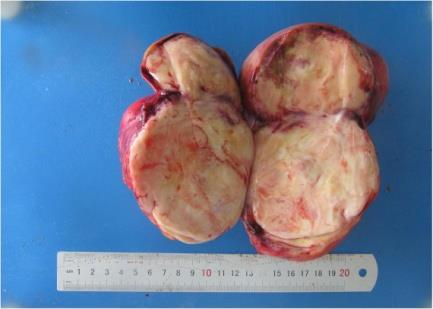| 1 |
KISHIMOTO Y, KISHIMOTO A O, YAMADA Y, et al. Dedifferentiated liposarcoma of the thyroid gland: a case report[J]. Mol Clin Oncol, 2019,11(3):219-224.
|
| 2 |
GUARDA V, PICKHARD A, BOXBERG M, et al. Liposarcoma of the thyroid: a case report with a review of the literature[J]. Eur Thyroid J, 2018,7(2):102-108.
|
| 3 |
ANDREA T, GIULIO G, GIULIANA L, et al. Primary dedifferentiated liposarcoma of the orbit, a rare entity: case report and review of literature[J]. Saudi J Ophthalmol, 2019,33(3):312-315.
|
| 4 |
TAMAKI T, DONG Y, OHNO Y, et al. The burden of rare cancer in Japan: application of the rarecare definition[J]. Cancer Epidemiol, 2014,38(5):490-495.
|
| 5 |
THWAY K. Well-differentiated liposarcoma and dedifferentiated liposarcoma: an updated review[J]. Semin Diagn Pathol, 2019,36(2):112-121.
|
| 6 |
OKAMOTO S, MACHINAMI R, TANIZAWA T,et al.Dedifferentiated liposarcoma with rhabdomyoblastic differentiation in an 8-year-old girl[J]. Pathol Res Pract, 2010,206(3):191-196.
|
| 7 |
CRAGO A M, DICKSON M A. Liposarcoma: multimodality management and future targeted therapies[J].Surg Oncol Clin N Am,2016,25(4):761-773.
|
| 8 |
KIUCHI K, HASEGAWA K, OCHIAI S, et al. Liposarcoma of the uterine corpus: a case report and literature review[J].Gynecol Oncol, 2018,26:78-81.
|
| 9 |
VON MEHREN M, KANE J M, BUI M M, et al. NCCN Guidelines Insights: soft tissue sarcoma, version 1.2021: featured updates to the nccn guidelines[J]. J Natl Compr Canc Ne, 2020,18(12):1604-1612.
|
| 10 |
SUAREZ-KELLY L P, BALDI G G, GRONCHI A. Pharmacotherapy for liposarcoma: current state of the art and emerging systemic treatments[J]. Expert Opin Pharmaco, 2019,20(12):1503-1515.
|
| 11 |
NIMURA F, NAKASONE T, MATSUMOTO H,et al.Dedifferentiated liposarcoma of the oral floor: a case study and literature review of 50 cases of head and neck neoplasm[J]. Oncol Lett, 2018,15(5):7681-7688.
|
| 12 |
GAHVARI Z, PARKES A. Dedifferentiated liposarcoma: systemic therapy options[J]. Curr Treat Option On, 2020,21(2):15.
|
| 13 |
HADDOX C L, RIEDEL R F. Recent advances in the understanding and management of liposarcoma[J]. Fac Rev, 2021,10:1.
|
| 14 |
YU J S E, COLBORNE S, HUGHES C S, et al. The FUS-DDIT3 interactome in myxoid liposarcoma[J]. Neoplasia, 2019,21(8):740-751.
|
| 15 |
DELORT L, BOUGARET L, CHOLET J, et al. Hormonal therapy resistance and breast cancer: involvement of adipocytes and leptin[J]. Nutrients, 2019,11(12):2839.
|
| 16 |
HIRATA M, ASANO N, KATAYAMA K, et al. Integrated exome and RNA sequencing of dedifferentiated liposarcoma[J]. Nat Commun, 2019,10(1):5683.
|
| 17 |
KIM Y J, YU D B, KIM M, et al. Adipogenesis induces growth inhibition of dedifferentiated liposarcoma[J]. Cancer Sci, 2019,110(8):2676-2683.
|
| 18 |
THWAY K, JONES R L, NOUJAIM J, et al. Dedifferentiated liposarcoma: updates on morphology, genetics, and therapeutic strategies[J]. Adv Anat Pathol, 2016,23(1):30-40.
|
| 19 |
IDBAIH A, COINDRE J, DERRÉ J, et al. Myxoid malignant fibrous histiocytoma and pleomorphic liposarcoma share very similar genomic imbalances[J]. Lab Invest, 2005,85(2):176-181.
|
| 20 |
DICKSON M A, SCHWARTZ G K, KEOHAN M L, et al. Progression-free survival among patients with well-differentiated or dedifferentiated liposarcoma treated with cdk4 inhibitor palbociclib: a phase 2 clinical trial[J]. JAMA Oncol, 2016,2(7):937-940.
|
| 21 |
VIJAY A, RAM L. Retroperitoneal liposarcoma: a comprehensive review[J]. Am J Clin Oncol, 2015,38(2):213-219.
|
| 22 |
HONG S H, KIM K A, WOO O H, et al. Dedifferentiated liposarcoma of retroperitoneum: spectrum of imaging findings in 15 patients[J]. Clin Imag, 2010,34(3):203-210.
|
| 23 |
张杰颖, 余小多, 宋艳, 等. 腹膜后去分化脂肪肉瘤的影像学表现及病理对照[J]. 中华肿瘤杂志, 2019,41(3):223-228.
|
| 24 |
陈 凯, 王培军, 张 宁, 等. CA125联合多参数MRI对卵巢肿瘤诊断效能评估[J].同济大学学报(医学版), 2022,43(5):684-689.
|
| 25 |
王成燃, 谷欣权, 高吉, 等. 原发性精索去分化脂肪肉瘤1例[J]. 中国实验诊断学, 2020,24(5):855-856.
|
| 26 |
LU J, WOOD D, INGLEY E, et al. Update on genomic and molecular landscapes of well-differentiated liposarcoma and dedifferentiated liposarcoma[J]. Mol Biol Rep, 2021,48(4):3637-3647.
|
| 27 |
RICCIOTTI R W, BARAFF A J, JOUR G, et al. High amplification levels of MDM2 and CDK4 correlate with poor outcome in patients with dedifferentiated liposarcoma: a cytogenomic microarray analysis of 47 cases[J]. Cancer Genet-ny, 2017,218-219:69-80.
|
| 28 |
谢晶, 王志华, 丁敏, 等. 去分化脂肪肉瘤11例临床病理分析[J]. 临床与实验病理学杂志, 2018,34(6):682-685.
|
| 29 |
JING W, LAN T, CHEN H, et al. Amplification of FRS2 in atypical lipomatous tumour/well-differentiated liposarcoma and de-differentiated liposarcoma: a clinicopathological and genetic study of 146 cases[J]. Histopathology, 2018,72(7):1145-1155.
|
| 30 |
YOKOYAMA Y, NISHIDA Y, IKUTA K, et al. A case of retroperitoneal dedifferentiated liposarcoma successfully treated by neoadjuvant chemotherapy and subsequent surgery[J]. Surg Case Rep, 2020,6(1):105.
|
| 31 |
DADONE-MONTAUDIE B, LAROCHE-CLARY A, MONGIS A, et al. Novel therapeutic insights in dedifferentiated liposarcoma: a role for FGFR and MDM2 dual targeting[J]. Cancers, 2020,12(10):3058.
|
| 32 |
CHOULIARAS K, SENEHI R, ETHUN C G, et al. Role of radiation therapy for retroperitoneal sarcomas: an eight-institution study from the US Sarcoma Collaborative[J]. J Surg Oncol, 2019,120(7):1227-1234.
|
| 33 |
CARBONI F, VALLE M, FEDERICI O, et al. Giant primary retroperitoneal dedifferentiated liposarcoma[J]. J Gastrointest Surg, 2019,23(7):1521-1523.
|
| 34 |
LI R, MAGLANGIT S, CARTAGENA-LIM J T,et al. Case of a huge recurrent retroperitoneal liposarcoma diagnosed in the second trimester of pregnancy[J]. BMJ Case Rep, 2021,14(7):e243639.
|
| 35 |
BEIRD H C, WU C, INGRAM D R, et al. Genomic profiling of dedifferentiated liposarcoma compared to matched well-differentiated liposarcoma reveals higher genomic complexity and a common origin[J]. Csh Mol Case Stu, 2018,4(2):a2386.
|
 )
)









